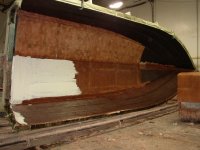dchurch3":c2d9e08l said:
I chipped off a piece of it (you can see the missing piece in the photo). It appears to be a thin fiberglass surface. The next layer down is not cracked and appears solid. It is yellow or brown and hard. I am wonderdering if that is more fiberglass or that a bilge liner was adhered to or if it is balsa? Can anyone describe the assembly?
I can't tell you exactly how the 25 is constructed in that area, but if it helps, fiberglass resin that has cured can be a brownish-yellow color.
I can also tell you how the hull of the 22 (and presumably the 25) is generally laid up (may not be specific to your boat). The hull is laid up in a female mold. So built "from the outside in."
1) Gelcoat sprayed into mold (this ends up being the shiny outside or bottom of boat).
2) Layers of fiberglass cloth (or other similar reinforcements) are laid in and saturated with resin.
3) A balsa (or other) core layer is laid in - probably around an inch thick - maybe a bit more.
4) More layers of fiberglass cloth are laid on top of the core and saturated with resin, excess resin is removed (squeegeed or some other way) (this layer could look yellowish brown, as the resin can cure that color).
5) Some sort of inside finish is applied. Some builders spray on gelcoat (which will end up looking more like paint and not super shiny like the molded gelcoat), some paint it on, some use paint.... it varies. I think the C-dory is some sort of applied gelcoat but not sure. This (if gelcoat or paint) could be the grey layer.
Layers 1-4 should be put on in close enough succession that they form a chemical bond, but... if some layers are added later for some reason (even later in the build process, maybe after the weekend, etc.), then they have to rely on a mechanical bond. Polyester isn't the best at secondary bonds (our boats are mostly built with polyester, as far as I know), so maybe something is de-bonding and cracking?
If your crack was all the way through layer #4, you would be down to the balsa core. However, you might not know it, because usually some resin/putty/slurry is used between the core and the adjacent fiberglass layers to sort of help "mush" it in and get an all-over bond without dry spots. So you could be seeing that (could be yellow-brown cured resin), and have a crack all the way through layer #4 but no currently obvious balsa because you are seeing resin/slurry (hardened of course). Of of course it could be something much more superficial - hard to tell without laying hands on it, or maybe seeing high-res photos that would enable major zooming. Can you clean the area to make it more obvious what's occurring?
Or, maybe layer #5 is simply lifting (the painted or sprayed on gelcoat layer) and you are seeing the top of the fiberglass (layer #4) and not the top of layer #3 (core)? What is the brownish patch to the left of the hose? Is that where more gelcoat has come off of the fiberglass maybe?
Just to be clear, I'm not saying I know you have a serious problem - I just can't tell. Sometimes something can look alarming and be nothing, or some dirt, or etc. But.... it does look like something I would want to get to the bottom of.
*********
Edited to add:
I looked at the photo some more and am thinking out loud:
1) If I'm seeing it correctly, that corrugated hose leads to a through hull - maybe for the bilge pump? Or maybe that's the pump itself at the end of the hose? It looks like that is in a circle about the size of a dinner plate that has no core (it's depressed). Maybe it is a mini-sump for the bilge pump, or an area of closed out (removed) core for a through hull? If that's the case, the way it could have been made is to have cut an area the size of a dinner plate out of the inner skin and then remove that core. Then new fiberglass (secondary, mechanical bond, probably)[ would have been laid into the depression and up over the side of the cut out core and onto the top. Maybe it would have overlapped the "virgin" hull by 6" or so. If this is the case, there would have to be an edge of that new top fiberglass layer. With a secondary bond in polyester is not uncommon to have it start to peel up at an edge. Could your "crack" be that edge?
2) What about that structure that looks like an angle supporting the tank? That looks like fiberglass. Is there a large layer of extra fiberglass extending out from that to help anchor it? If so it could be the same "secondary/mechanical" bond situation as I mentioned in #1 just above.


